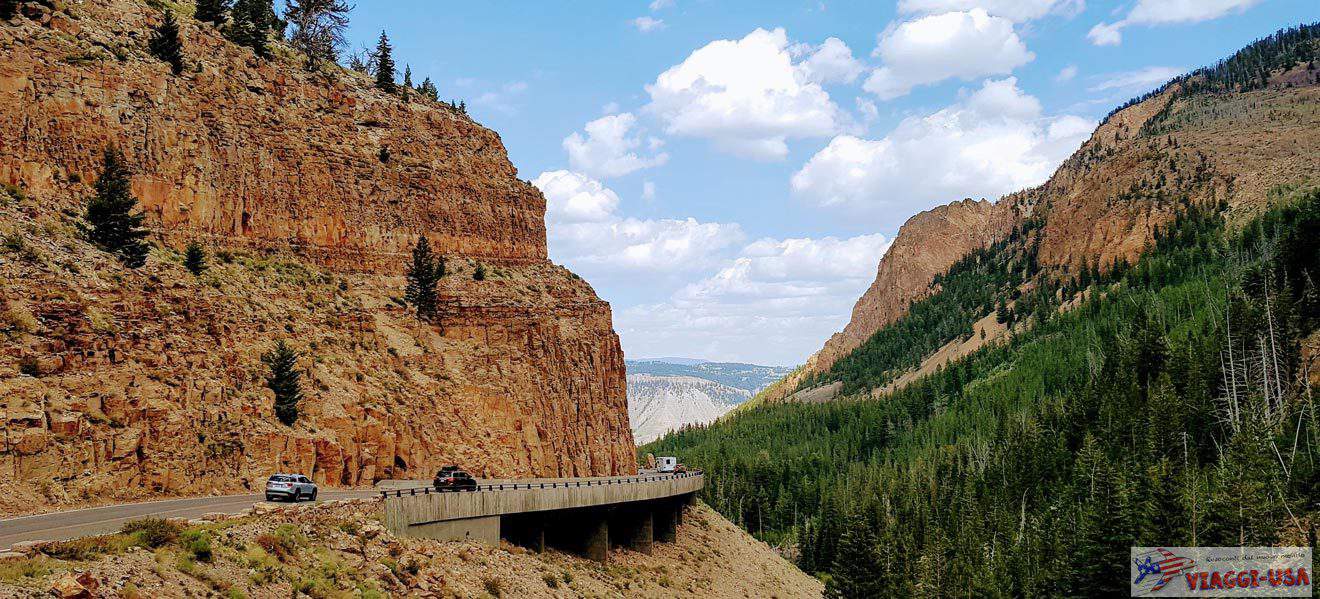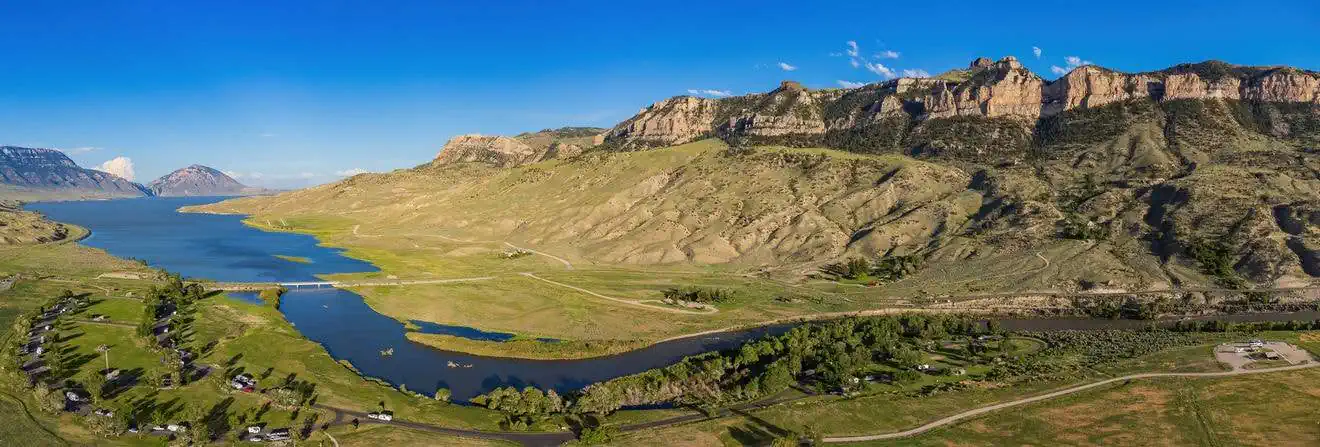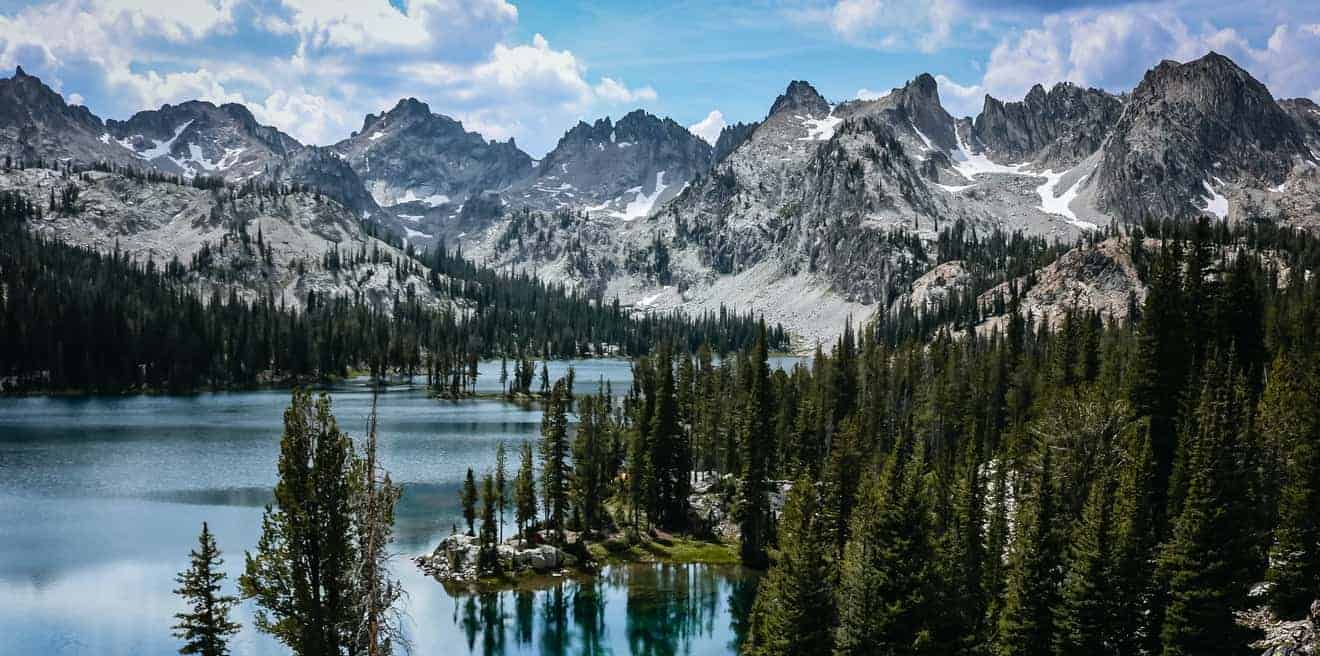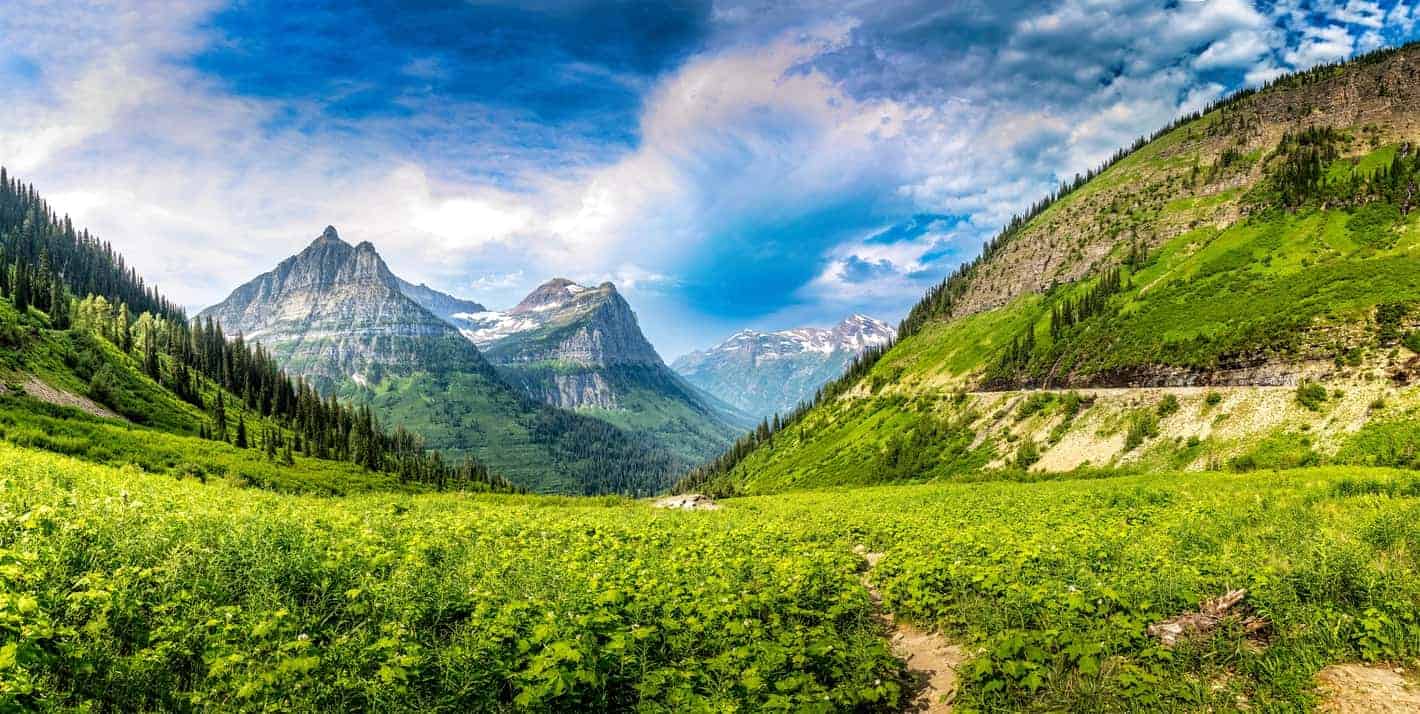Yellowstone Park is the oldest national park in America, as well as one of the largest (it encompasses 3 states) and most fascinating. Yellowstone’s attractions are truly spectacular, helping to make the visit a once-in-a-lifetime experience.
It’s here that you’ll find more than half of the world’s geysers, beautiful multi-colored hot springs, spectacular mountain lakes, deep and striking canyons, fumaroles, waterfalls, sulfur springs, and a diverse array of wildlife (including bears, bison, elk, cougars, some wolves).
It is difficult to find such a concentration of natural wonders in one place and it is no coincidence that the park was declared a World Heritage Site by UNESCO in 1978. So let’s take a look at some tips on how to visit it and the best things to do in the park.
Tips for visiting Yellowstone National Park
As already mentioned, Yellowstone National Park is immense, and visiting it will require careful planning, especially in summer, when the park is taken by storm by tourists. Here is some information to take into account:
Yellowstone how to get there and where it is
Yellowstone is located at the northwest end of Wyoming, bordering on Montana and Idaho in some stretches. The park has 5 entrances, 2 of which are in Wyoming and 3 in Montana. Below, along with the map, are the entrances to Yellowstone arranged clockwise starting from the west:
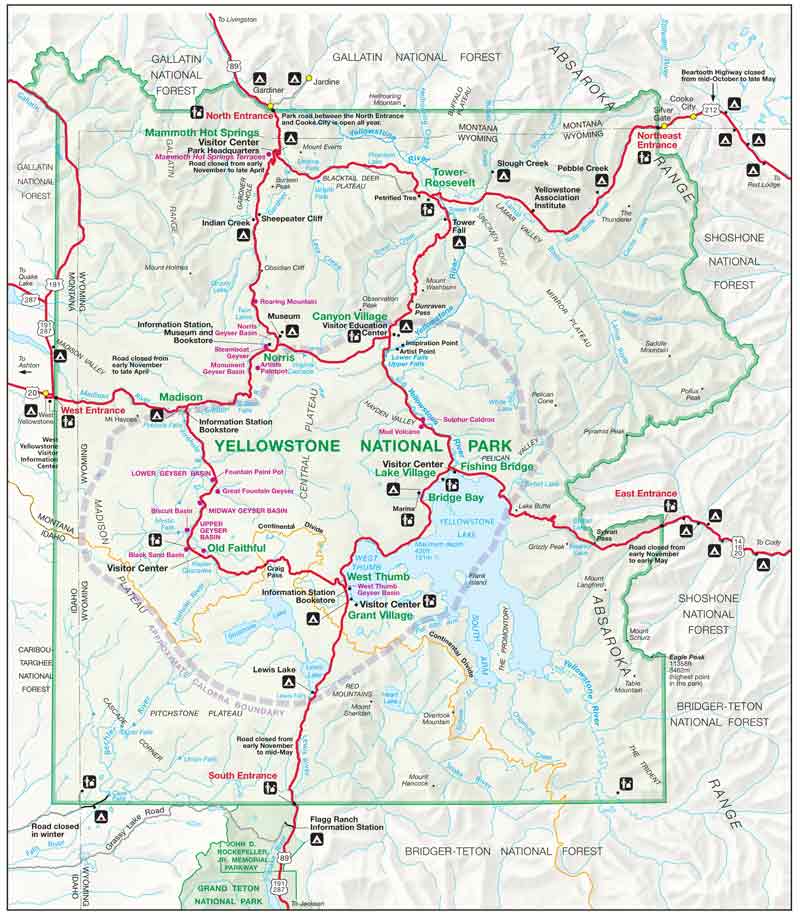
- West Entrance: this is accessed from US-20 and provides access to the park near the Madison River. This area is the geyser area, which you will find both in the south (Upper, Midway and Lower Geyser Basin) and north (Norris Geyser Basin) direction. The nearest town is West Yellowstone and the entrance is open from late April to early November, while snow-equipped travel vehicles can enter from mid-December to mid-March.
- South Entrance: this is the entrance through Grand Teton National Park. The entrance is open from mid-May through early November and allows snow chains from mid-December through mid-March.
- East Entrance: this is the best entrance to visit Yellowstone Lake and then drive up Hayden Valley. The nearest town is Cody. The opening periods are similar to those of the south entrance, with the slight difference that during the winter it closes at the beginning of March.
- North-East Entrance: the closest entrance to Lamar Valley. Nearest City: Cooke City. In winter some roads east of Cooke City may close due to inclement weather.
- North Entrance: the only entrance open year-round, in winter it is the only working link to Cooke City. If you are planning a winter visit, bear in mind that the road from Mammoth to Norris is closed from early November to late April. The nearest town is Gardiner.
The closest entrance to the main attractions is the western entrance. For more info on which access is best to use, check out my guide to all Yellowstone entrances.
Yellowstone Entrance Fee
Yosemite National Park is managed by the NPS (U.S. National Park Service) and therefore requires an entry fee. Here are the prices:
- private non-commercial cars and vehicles: $35 per vehicle
- motorcycles and snowmobiles: $30 per vehicle
- individual admission (walking, biking, etc…): $20 per person
You can also access with the National Park Card, which saves on the entrance fee if you visit other U.S. national parks during your trip.
How to get around the park
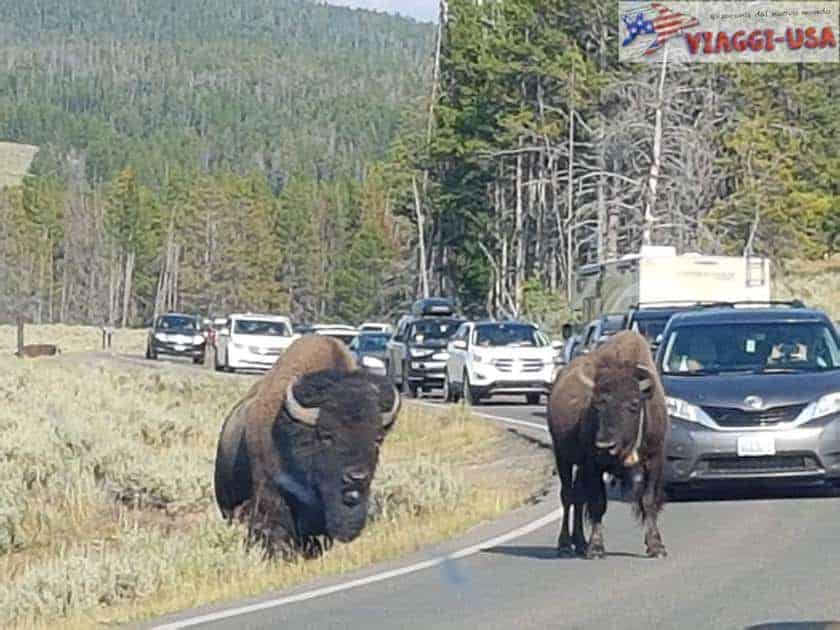
The best way (I would say the only way) to travel in the park is to explore it by car. It is the ideal way to reach the various attractions, which are quite distant from each other (to rent a car take a look at our advice on renting a car USA). There are also companies that offer guided tours, but they are quite expensive. The main things to see are all in the area of or within a short distance from the Loop Road, a 198 miles internal road in the shape of an 8 to which all 5 entrances are connected. The speed limit is about 44 miles per hour and it is a good idea to stick to it as the crossing of bison and other wild animals is quite frequent. Not infrequently, precisely because of these episodes, real traffic jams are created that you will have to endure with patience.
You will need to take into account that moving around could take longer than expected. Expect to find full parking lots in the areas close to the main attractions, but if you are well organized, leaving early in the morning, you can explore the park without getting too annoyed. By the way, in the parking areas, even when they are full, do not lose faith, many visitors tend to snub the parking lots and I happened more than once to take advantage of this and find room in spaces that many snubbed. Once you have parked your car, some of the most beautiful walks that Mother Nature has to offer are waiting for you. They are also convenient, as there are comfortable walkways in the main geothermal areas.
Where to get gas
Even if it is not always possible, I suggest you buy gasoline outside the park. If you forget, don’t worry, there are many gas stations in Yellowstone, all close to the main villages that you will come across on the loop road. Here is a list of areas to keep in mind so you don’t run out of gas:
- Old Faithful
- Canyon Village
- Tower-Roosevelt
- Mammoth Hot Springs
- Lake Village
- Grant Village
Stations are located near almost every major attraction, which will make your trip more relaxing.
How many days to visit Yellowstone?
If you want to visit the main attractions of Yellowstone National Park, you should plan at least 3 days. If you have less time, concentrate on one or two areas, so that you can devote the necessary time to them. To get an idea, I recommend you refer to my Yellowstone itinerary where you will find a ready detailed itinerary that can be adapted to the number of days you have available (from 1 to 4 full days).
Where to stay in Yellowstone Park

Please note: To provide further help in finding the right accommodation in and around Yellowstone we have created a dedicated article: read our guide on where to stay in Yellowstone.
Below you will find some general guidelines. Sleeping in Yellowstone means you can choose from a variety of options. You can choose to sleep inside the park, which is more convenient but also more expensive (hotels fill up quickly so try to book as soon as possible!), or look for an overnight stay just outside Yellowstone, at the park entrances. In addition to being cheaper, the latter option may also work well depending on the travel itinerary you have planned, and the direction you come from. Here are the cities where you can book a hotel at the various entrances:
- North Entrance: Gardiner. Find a hotel in the area
- South entrance: Grand Teton National Park. Find a hotel in the area
- West entrance: West Yellowstone. Available hotels
- East entrance: Cody. City hotels list
- Northeastern entrance: Cooke City. Search a hotel in town
If you are looking for a hotel in Yellowstone, I suggest you take a look at our section in the article we already mentioned or at the link below:
Nearby airports: where to land

Yellowstone National Park can often be quite far off the beaten West Coast itineraries, so you have 2 options: drive there or approach with an internal flight. In the first case, the international airports to consider are:
- Salt Lake International Airport, about 5 hours drive from the park
- Denver International Airport, about 8 hours driving from the park
Both airports are considered the gateways to the West Coast Real America. Both airports are considered gateways to the West Coast, a large region that includes the states of Wyoming, Montana, South Dakota, and North Dakota. For your rental car search, I suggest you take a look at our guide on how to rent a car in the USA. If instead, you prefer to approach Yellowstone with an internal flight these are the useful airports:
- Cody, WY
- Jackson, WY
- Bozeman, MT
- Billings, MT
- West Yellowstone, MT. Served from June to early September from Salt Lake City, Utah
- Idaho Falls, ID
Best time to visit Yosemite National Park?

The most popular months are July and August, they are great for visiting the park, the only drawbacks are the many visitors and higher costs. If you can take your vacation earlier, you can also opt for June, or visit the park in the fall, when Yellowstone can offer truly spectacular colors. In both cases, you must always pay attention to the opening periods of the entrances (which you can find a few paragraphs above). In winter the park is much more complex to visit, especially because many roads are closed (the only open entrance is the North Entrance), as we have already explained here. To have more details on what kind of weather and problems to expect during the different seasons you can read our guide on the best time to go to Yellowstone.
Where to eat

Let’s get to the less happy notes. There are many restaurants in Yellowstone, usually near the villages that you will find at the turns of the loop road, but at least in most cases you can’t expect much, especially in terms of variety and prices. Personally I recommend using lunchboxes, lunch boxes that you can pick up in neighboring towns, here are 2 examples for West Yellowstone:
- Ernie’s Bakery and Deli, 406 Hwy 20, West Yellowstone, MT
- Running Bear Pancake House, 538 Madison Ave, West Yellowstone, MT (this place is great for breakfast too, pancakes and fresh fruit to die for)!
You can choose one of the many picnic areas in the park. On this page you will find the complete list with the number of tables available. However, if you find yourself running out of stock, Yellowstone’s restaurants or cafeterias can always come in handy. Here are all the places to stop for a snack:
- Canyon Village: Canyon Lodge Cafeteria and Canyon Lodge Dining Room, General Store, Adventure Store, Lodge Picnic Shop
- Grant Village: Grant Village Restaurant and Grant Village Lakehouse Restaurant, General Store and Mini Store
- Lake Village: Lake Yellowstone Hotel Dining Room, Lake Lodge Cafeteria, Fishing Bridge General Store, Hotel Deli, and General Store
- Mammoth Hot Springs: Mammoth Hot Springs Hotel Dining Room, General Store, and Terrace Grill
- Old Faithful Village: Old Faithful Inn Dining Room, Old Faithful Snow Lodge Restaurant, Old Faithful Lodge Cafeteria, Basin Store, Photo Shop, BAC Store, Four Seasons Snack Shop, Pony Express Snack Shop, Lodge Snack Shop
- Tower-Roosevelt: Roosevelt Lodge Dining Room, Tower Fall Store
Safety tips
Although many animals in the park are accustomed to visitors, the wildlife is still wild and should not be disturbed. There are dangerous animals in the park such as bears, bison, wolves, elk and others. Follow park guidelines to the letter, especially when it comes to bears. If you want to know where to go to spot specimens of the park’s wildlife, you might find the article I wrote about it useful: Best Places to See Wildlife in Yellowstone and Grand Teton. In the thermal areas, always stay on the boardwalks: the terrain, although it seems safe, is not. If you don’t follow the park’s directions, you risk burns, even serious ones, as well as hefty fines.
How to visit Yellowstone with baby

Yellowstone is definitely a family-friendly park, even with young children. Aside from the traffic and summer crowds, the ability to explore these incredible natural wonders on comfortable boardwalks makes it a fairly easy visit and suitable for children of any age. For a list of stroller-friendly trails, see my article: Yellowstone with Baby: Stroller Friendly Trails and Toddler Hikes.
Best things to do in Yellowstone
Here we are finally at the point: what to do in Yellowstone? What are the absolute must-see Yellowstone attractions? I have divided the park into 5 areas for convenience, so as to facilitate the planning of a tour as much as possible. You can use the attractions map below to plan your trip. I remind you that if you are looking for a ready-made and tested itinerary, you can refer to my Yellowstone route.
The geyser region

The geysers of Yellowstone are probably the most representative attraction of the park. The area of greatest concentration is to the west, particularly in the Upper Geyser Basin, Midway Geyser Basin, Lower Geyser Basin, West Thumb Geyser Basin, and Norris Geyser Basin areas. On the map you will find the main landmarks to understand where they are located. A warning: in certain areas some geysers erupt at fairly regular intervals, it is especially the case of the Upper Geyser Basin, whose visitors center (Old Faithful Visitor Center) you can find the times of the eruptions expected, very convenient to plan well the time of the visit. For more information read our Upper Geyser Basin guide.
Upper Geyser Basin
This is the southernmost basin and is the most popular area of Yellowstone. Here you will find the highest concentration of geysers in the world, many of which erupt at predictable times. The visit takes place along comfortable wooden walkways, which allow you to admire not only geysers but also fumaroles, hot springs, and boiling mud.
- Old Faithful: The park’s most famous geyser. It erupts every 78 minutes with a powerful jet of water that can reach up to 55 feet. Relax while sitting on the surrounding crescent of concentric benches and enjoy the show.
- Grand Geyser: Continue your walk on the wooden walkways provided to the Grand Geyser, which erupts twice a day with jets over 200 feet high.
- Morning Glory Pool: Spectacularly colored hot spring, ranging from yellow to orange to turquoise.
To discover all the attractions and organize a visit to this area please read my article on how to visit Old Faithful and Upper Geyser Basin.
Midway Geyser Basin

Here, along with other hot springs and inactive geysers, you will find one of Yellowstone’s most impressive attractions, Grand Prismatic Spring, an authentic wonder of nature that we have already told you about in our dedicated in-depth article, and also in our itinerary from Painted Hills. This is a quicker area to visit than the Lower Geyser Basin, in fact, it includes 3 hot springs and 1 inactive geyser, and most of the time is spent trying to do justice to the beautiful colors of the prismatic spring in photos. You can also see it from above, with a trail leading to a raised platform with a spectacular view of the basin. To arrange a visit to this area, please refer to our article on how to visit Grand Prismatic Spring and Midway Geyser Basin.
Norris Geyser Basin
A (slightly) less crowded area, dotted with vents and fumaroles. Although it is less famous than the first 2, in my opinion it should absolutely not be missed, especially for these 3 attractions:
- Porcelain Spring: A fanciful expanse of hot springs, geysers, and fumaroles that will give you the impression of being in front of an immense palette of colors.
- Echinus Geyser: The largest acid water geyser in the world. It erupts at irregular intervals (35 to 75 minutes).
- Steamboat: the tallest in the world, with its jets over 275 feet. Eruptions are not predictable.
To plan a visit to this area, please refer to my guide on how to visit Norris Geyser Basin.
West Thumb Geyser Basin
Another basin studded with geysers, turquoise pools, and fumaroles. West Thumb is to be found directly behind the clear Yellowstone Lake, from which it derives its name (West Thumb is the name of the part of the lake bordering this hydrothermal basin, which, when seen from above, looks like the thumb on a hand).
Two of the hot springs that are particularly striking are Abyss Pool, one of the deepest of the entire park (52 feet), and Black Pool, which was once really black. The Twin geysers, which in reality is only one geyser with 2 vents, and small volcanic craters near the lake (Fishing cones) are also of interest.
Mammoth Hot Springs
Be sure to visit the northwest area, where the most amazing attraction is represented by Mammoth Hot Springs, a series of travertine terraces in very unique shapes, where waterfalls wrapped in steam descend amidst wonderful hues of color. The impression is that of being in front of petrified waterfalls, but to describe such a spectacle is almost impossible. Take a look at the photos, you’ll get a better idea….
In this case too, the path follows the usual wooden walkways, although in this case, the walk can be slightly more challenging as the site is vertical, with many stairs and few shaded areas. A short distance away, you will also find Fort Yellowstone, a historical site where the American army was stationed for about thirty years.
To plan a visit to this area please read my article on how to visit Mammoth Hot Springs.
Grand Canyon of the Yellowstone
Could such a wonderful park lack a deep, evocative canyon? Certainly not! It may not be as famous as the Grand Canyon in Arizona, but the Grand Canyon of Yellowstone (dating from 10,000 to 14,000 years ago) is very impressive: about 20 miles long, 800 to 1200 feet deep, and 1500 to 4000 feet wide. Chemical processes over the millennia have helped create variegated colored stripes and patches in the canyon rock also graced by 2 mighty waterfalls: Upper Falls and Lower Falls. Various hikes are possible, especially along Uncle Tom’s Trail, a 300+ step trail that descends the cliff face allowing a closer look at the power of the Lower Falls, while one of the best viewpoints is Artist Point, which offers an unparalleled frontal view of the falls themselves. We have talked about all this and much more in our guide dedicated to the Grand Canyon of the Yellowstone.
The Lakes of Yellowstone National Park
Yellowstone Lake is another popular stop for visitors to the park, perhaps because it is the largest alpine lake in all of North America, or perhaps because on the west shore, there is West Thumb Geyser Basin, whose hot springs flow directly into the lake. A bit more hidden, but still interesting, are Shoshone Lake and Heart Lake, excellent destinations for a hike.
The Yellowstone valleys where to see wildlife

Another feather in the park’s cap is its lush valleys, such as Hayden Valley and Lamar Valley, which are ideal areas for sighting wild animals, especially bison, that create long lines lurking along the roads. There are also bears, Rocky Mountain goats, wolves, etc… Crossing these valleys often means traveling at a walking pace, but at the same time, it is a wonderful experience and gives you the opportunity to admire the animals up close in a beautiful setting.
- Hayden Valley is located more or less in the center of the park, between the Grand Canyon and Yellowstone Lake
- Lamar Valley is further north, between the Roosevelt area and the Northeast Entrance
Minor Yellowstone attractions

Those listed so far are just Yellowstone’s main attractions, but as you travel the length and breadth of the park, you’ll find numerous areas that signposted are somehow considered “minor attractions”. In many other parks, they would actually take the lion’s share of the action.
You will encounter numerous waterfalls: 2 that deserve special mention are Tower Fall, near Tower-Roosevelt, a strategic stop in Lamar Valley, and Gibbon Falls, between Madison Junction and Norris Geyser Basin. In both cases, these are rather quick stops, suitable for taking a few souvenir photos and then moving on again.
There are also many other hydrothermal basins full of geysers and fumaroles:
- in the Old Faithful area, you will also find the Lower Geyser Basin, home to one of the most famous mud pots in the park (Fountain Paint Pot), and the Great Fountain, one of the great Yellowstone geysers with a predictable eruption (the times are projected on a screen at the Old Faithful Visitor Center). Also in the surrounding area, there are other smaller areas to visit, such as Biscuit Basin and Black Sand Basin, both of which I have already mentioned as optional stops on my Yellowstone itinerary.
- in the Hayden Valley area, you can make 2 quick stops at Mud Volcano (where it is not uncommon to find our old bison friends) and at Sulphur Caldron, the most acidic hot spring in the park.
- near Norris Geyser Basin there are at least 3 other points of interest: Artists Paintpots (geothermal basin with many colors), Monument Geyser Basin (with geysers of a particular shape and beautiful views over the surrounding prairies), and Beryl Spring (also visible from the car).











